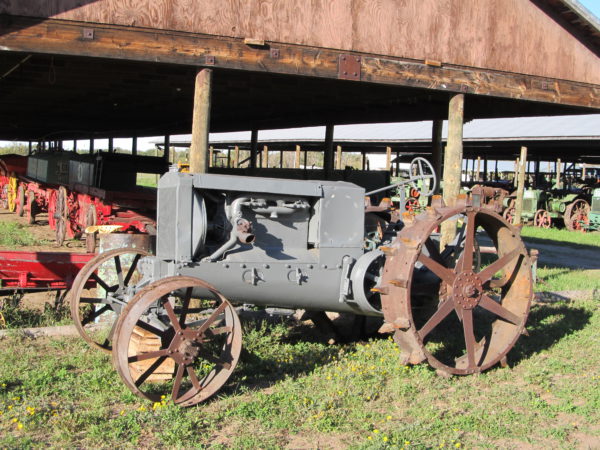
With the death of J.I. Case in 1891 and the resulting financial troubles, the Case group of companies was split into two entities, the J.I. Case Threshing Machine Company and the J.I. Case Plow Works. Henry Wallis, a son-in-law of J.I. Case, took over J.I. Case Plow Works in 1892.
In 1912 Henry Wallis entered the tractor business and established the Wallis Tractor Company. Right from the start the Wallis Tractor Company built tractors that were well engineered. In 1914 Wallis was building the “Cub”, a technologically advanced machine that was, however, massive in size. The Cub weighed 8,500 pounds with a 52 horsepower engine.
The Cub introduced an important innovation, the use of boiler plate formed into a U shape which formed the engine crankcase and the case for the transmission. A bulkhead divided the crankcase and transmission case. This one piece case provided a stiff foundation for the tractor. Enclosed final drives soon followed. Wallis used roller bearings where possible and was known for the use of high quality materials in construction.
In 1917, Wallis introduced the “Cub Junior” Model J which was much more suitable for the average farmer, weighing only 3,000 pounds and producing 25 horsepower on the belt. The U shaped boiler plate forming the unitized crankcase and transmission case was retained. All gears were enclosed and ran in oil. The Model J featured a tricycle layout with a single front wheel.
In 1919 the Model J was updated and renamed the Model K with the major difference being a the front end was changed to an axle with two wheels. The tractor did not feature rear fenders, a low price being more important than safety and comfort to most farmers. The basic Wallis design was so good that when Massey Harris (MH) purchased Wallis and the J.I. Case Plow Company in 1928, MH continued the manufacture of Wallis tractors.
While MH was a major Canadian manufacturer of farm machinery, MH never built steam engines and up to the purchase of the J.I. Case Plow Company and Wallis, never had their own design of gas tractor to sell. With the growth of gas tractor sales after 1910, MH realized it needed a fast tractor to sell. In 1917, MH attempted to secure the popular US made Bull tractor, for sale through its dealers. However the deal fell apart. MH then secured the manufacturing rights to the Parrett tractor. The tractor entered production in Toronto in 1918 and stayed in production until late 1922 going through three versions which incorporated various improvements. In 1922, MH realized it could not compete with the Fordson tractor which cost 1/3 the price of the MH Parrett, so MH ceased production of the tractor. However MH realized that a tractor line was still needed and attempted to strike an agreement with the J.I. Case Plow Works to sell this company’s line of Wallis tractors in Canada through MH dealers. In 1928, after complicated negotiations, MH purchased the J.I. Case Plow Works, immediately selling the name to the J.I. Case Threshing Machine Company for ½ the price MH had purchased J.I. Case Plow Company for. The purchase of the Plow Works gave MH production plants in the US. MH sold Wallis tractors until 1932 when the tractors were re-badged as Massey Harris.


